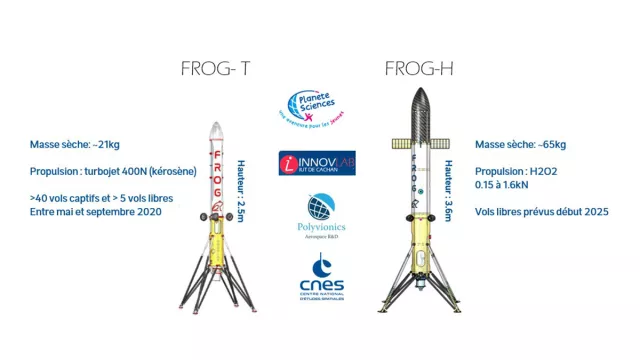FROG is a low-cost platform designed for testing the flight control systems of a reusable vertical take-off, vertical landing (VTVL) launcher stage. The project was launched and is being funded by CNES and executed in partnership with non-profit association Planète Sciences, Polyvionics and the IUT Cachan technology institute (Paris Saclay University). FROG is the smallest demonstrator in CNES’s reusable launcher stage roadmap.
Key information
| Mission | Small-scale VTVL demonstrator |
|---|---|
| Domain | Space transportation |
| Start date | 2017 |
| Partners | Planète Sciences, Polyvionics, IUT Cachan technology institute/Innov’Lab, Drones-Center, Sonatronic, Lukasiewicz Institute of Aviation (Warsaw), ESA |
| Where | BA217 launch base, Brétigny-sur-Orge, for tests up to less than 1 kilometre |
| Lifetime | Indefinite |
| Status | In development |
Key figures
- 5 free flights accomplished by FROG-T
- 3 m 60: height of FROG-H demonstrator
- 400 m: maximum test altitude
- 100 kg: launch mass of FROG-H
Key milestones
- Start 2025: First free flights of FROG-H
- Summer 2024: Testing of FROG-H’s H2O2 engine
- December 2022: FROG-H detailed definition key point
- October 2020: Free flights of FROG-T up to altitude of 30 m at Brétigny-sur-Orge
- End May 2019: First captive flight with turbojet
- 2017: Project kick-off
Project in brief
There are limits to what simulations can do, which is where real-life testing comes into play. This is the thinking behind FROG, an agile, experimental test platform devised by CNES.
FROG is a recursive acronym that stands for ‘Frog, a ROcket for GNC demonstration’. Initiated by CNES’s Launch Vehicles Directorate (DLA) to test landing algorithms for reusable launchers, FROG is a suite of small-scale demonstrators of vertical take-off, vertical landing (VTVL) concepts. Standing 2.5 metres tall and with a diameter of 30 centimetres, FROG-T is designed as a learning vehicle. Teams at CNES’s Space Transportation Directorate (DTS), working with partners from industry (Polyvionics and Drone-Center), academia (IUT Cachan technology institute) and associations (Planète Sciences), are plugging new guidance, navigation and control (GNC) algorithms into the demonstrator to test new solutions in responsive fashion and with short development times. Once validated, these concepts may be incorporated in larger architectures like the Callisto and Themis reusable demonstrators and other projects coming on stream in the decade ahead. Besides GNC technologies, FROG-H could also serve as a flying testbed for other technologies designed to acquire innovative measurements, for example.
The FROG-T prototype, currently powered by a turbojet, made its first flight at the end of May 2019. The vehicle is fully equipped to land vertically, with a steerable nozzle, active attitude control and four legs to absorb the shock of landing. It is now entering its operational phase and will be used, for example, for the Horizon Europe SALTO project. A smaller electric version (FROG-E) also exists and a version with a small rocket engine (H2O2) is in development, to be called FROG-H. This version will make FROG more representative in terms of propulsion. Its engine, developed by the Lukasiewicz Institute of Aviation in Warsaw under contract to ESA, will be tested in the summer of 2024. The first flights of FROG-H are planned for early 2025.
FROG is also seeking to break free from traditional development methods by turning to contributors from outside DTS. Several teams of enthusiasts are developing and testing solutions concurrently through an agile, experimental approach to think outside the box and rapidly devise new control methods.
CNES’s role
CNES is the initiator of the FROG project, providing funding and technical support.
Contacts
Project Leader
Elisa Cliquet Moreno
E-mail: elisa.cliquet at cnes.fr
Head of Space Transportation Strategy
Philippe Pujes
E-mail: philippe.pujes at cnes.fr


